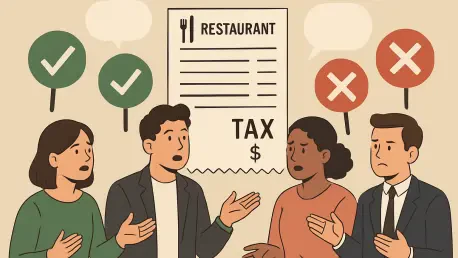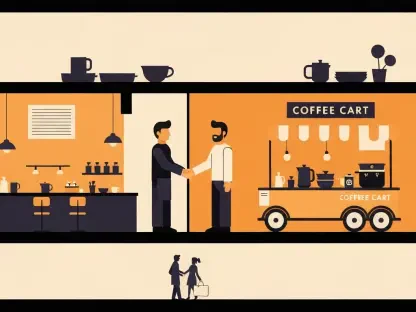In a bustling restaurant on a busy Friday night, a group of eight friends gathers to celebrate a milestone, unaware that the automatic service charge on their bill is at the center of a heated debate within the hospitality industry. A newly implemented tax provision, part of a broader legislative act, has introduced significant changes to how tips and mandatory gratuities are treated for tax purposes. This policy, effective from this year through 2028, allows certain workers to deduct a substantial amount of qualified tips from their taxable income. However, the exclusion of mandatory service charges—those automatic fees often added to bills for large parties—has sparked frustration among restaurant owners and employees alike. As the industry grapples with this disparity, many establishments are reevaluating their policies on gratuities for large groups, seeking ways to balance compliance with fairness to their staff. This evolving situation promises to reshape how restaurants approach service charges in the coming years.
Navigating the New Tax Landscape
The core of the current challenge lies in the distinction between voluntary tips and mandatory service charges under the new tax law. While tipped workers can deduct up to $25,000 annually in qualified tips from their taxable income, the automatic gratuities—typically ranging from 15% to 20% for parties of six or more—are not eligible for this benefit. This exclusion has created a significant point of contention within the food service sector, where many argue that there is no practical difference for employees between earning voluntary tips and receiving income from auto-gratuities. Industry advocates, including prominent unions and lawmakers from states like Nevada, have called on federal authorities to reconsider this policy, stressing that the current rules create unfair disparities among workers based solely on their employer’s tipping structure. The frustration is palpable as stakeholders push for a more inclusive definition of deductible tip income to level the playing field for all tipped employees in the industry.
Compounding the issue is the stance of regulatory bodies, which appear unlikely to shift their position despite mounting pressure. Proposed rules released by the Internal Revenue Service in recent months have upheld the separation between voluntary tips and mandatory charges, aligning with what some policy experts describe as the clear intent of the legislation to limit deductions to discretionary gratuities. This rigid interpretation has left many in the restaurant sector feeling sidelined, as they believe the policy fails to account for the realities of how compensation is structured in their industry. For servers and other tipped staff, this means that a significant portion of their income may remain taxable, even as their peers in voluntary tip environments benefit from substantial tax relief. As the final rules are still pending, the uncertainty continues to loom large over restaurant operations, prompting a cautious approach from many business owners who are eager to see how the situation unfolds before making drastic changes.
Industry Responses and Adaptations
Restaurant operators across the country are currently in a state of limbo, adopting a wait-and-see approach as they monitor the development of final tax guidelines. Many are focused on ensuring that their tipped employees can maximize any available tax benefits, recognizing that the potential for higher take-home pay is a key reason many choose to work in this field. Industry leaders from national associations have emphasized the importance of aligning business practices with the new regulations while maintaining employee satisfaction. Some establishments are already consulting with financial experts and technology providers to explore adjustments to their point-of-sale systems that could better categorize gratuities in line with the tax policy. This proactive stance reflects a broader concern about maintaining a competitive edge in a tight labor market, where the ability to offer attractive compensation packages can make all the difference in attracting and retaining talent.
Meanwhile, competitive pressures are beginning to influence how restaurants structure their tipping models. In regions where voluntary tipping allows servers to access significant tax deductions, employees at establishments relying on mandatory service charges may feel disadvantaged, potentially prompting them to seek work elsewhere. Representatives from state-level hospitality associations have noted that this disparity could lead to a shift in workforce dynamics, with businesses feeling compelled to revise their gratuity policies to remain appealing to skilled staff. Such changes are not without challenges, as altering tipping structures can impact overall revenue and customer perceptions of value. For many restaurant owners, the decision involves a delicate balance of financial considerations, employee morale, and market positioning. As these competitive forces play out, the industry appears poised for a period of transformation, with adaptability becoming a critical factor in navigating the new tax environment.
Looking Ahead to Policy Impacts
Reflecting on the developments that have unfolded, the introduction of the tax provision on tips marked a pivotal moment for the restaurant industry, particularly in how it addressed mandatory gratuities for large groups. The exclusion of these automatic charges from deductible income stirred significant debate, with advocacy efforts from unions and lawmakers highlighting the need for equitable treatment of all tipped earnings. Although the regulatory stance remained firm in its distinction between voluntary and mandatory gratuities, the pushback from stakeholders underscored a broader desire for fairness in tax policy.
Moving forward, restaurants are encouraged to strategize on multiple fronts, from exploring innovative tipping models to investing in systems that can streamline compliance with evolving rules. Collaboration with financial advisors and industry associations has emerged as a vital step in crafting sustainable solutions. Additionally, keeping a close eye on future legislative updates offers hope for potential revisions that might address the current disparities. The path ahead demands resilience and foresight, ensuring that the hospitality sector can adapt to both regulatory outcomes and shifting market dynamics with confidence.









